| Dear Friend,
Thank you, and I mean it.
You know, it seems there are a lot of companies out
there that just want to grab your money and run. Not me, I'm different. I
want you to know that I truly appreciate your business and that this is
the beginning of a relationship, not the end.
First off, I would like to thank you for choosing
HomeFront Inspection and Building Consulting Service for your home buying needs. I
am your home consultant for life.
It is very important that you read and understand
this material before you come to the inspection. This will save us
both valuable time during the inspection.
Please read
the following:
First read: "Understanding
what a home inspection is
and is not"
Second read: "Understanding the purpose of a
Home Inspection"
Third read: "The Inspection Agreement"
Here are some other services that you may need.
|
Thermal Imaging Explained
Thermal imaging is a non-invasive method of detection
defects invisible to the naked eye. Without thermal imaging, defects such
as these below can go unnoticed and undetected. The inspector is not
responsible for what he can not see.
Thermal Imaging goes way beyond the regular visible
home inspection. We have the ability to see what other inspectors can not
see.
Without thermal imaging you my be missing defects
that later will cost you.
NOTE:
If you choose not to include Thermal
Imaging, you must sign a release form which relieves the inspector's responsibility
for defects that thermal imaging could have detected.
What is Thermal Imaging?
 |
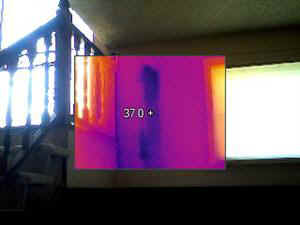 |
What you See |
What I see with Infrared |
Thermal Imaging, AKA Infrared, is a powerful, noninvasive method of monitoring and
diagnosing the condition of houses. With it, I can quickly identify problem areas that
can't be detected with the naked eye - eliminating costly, destructive probing methods.
Infrared thermography cameras produce images of invisible infrared, or "heat"
radiation and provide you with precise non-contact temperature measurements.
Invaluable for moisture problems and mold problems!
Moisture in building materials can destroy the structural integrity and nurture mold
and insect infestation. Infrared cameras can instantly image entire rooms, inspect
hard-to-reach places, reveal wet conditions behind surfaces at the source, and then
monitor when the area is completely dry.
Perfect for finding hot spots!
For mechanical equipment, nearly everything gets hot before it fails - making infrared
cameras extremely cost-effective and valuable diagnostic tools in many diverse
applications.
What can infrared cameras do for you?
Infrared cameras meet the demands of building diagnostics. They feature immediate
high-resolution thermal imagery, which reveals potential structural and moisture issues,
energy efficiency and even rodents or pests. Use an infrared camera to find:
- Moisture
- Missing or defective insulation
- Structural shortcomings
- HVAC problem areas
- Sourced of heating/cooling losses
- Plumbing blockages
- Roof leaks
- Electrical issues
- Rodents and other pests
- And much more!
Thermal Imaging is an added service to your standard home inspection, so please request
this valuable service when scheduling your home inspection.
Here are some of the "Hidden" Problems I found in homes that had little or no
indications of moisture problems.
| What you See |
What I see with Infrared |
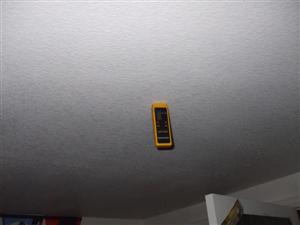 |
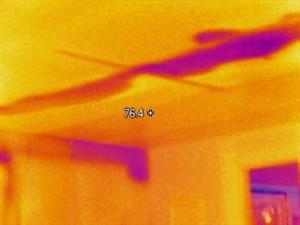 |
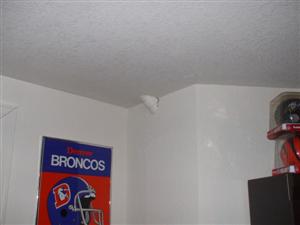 |
 |
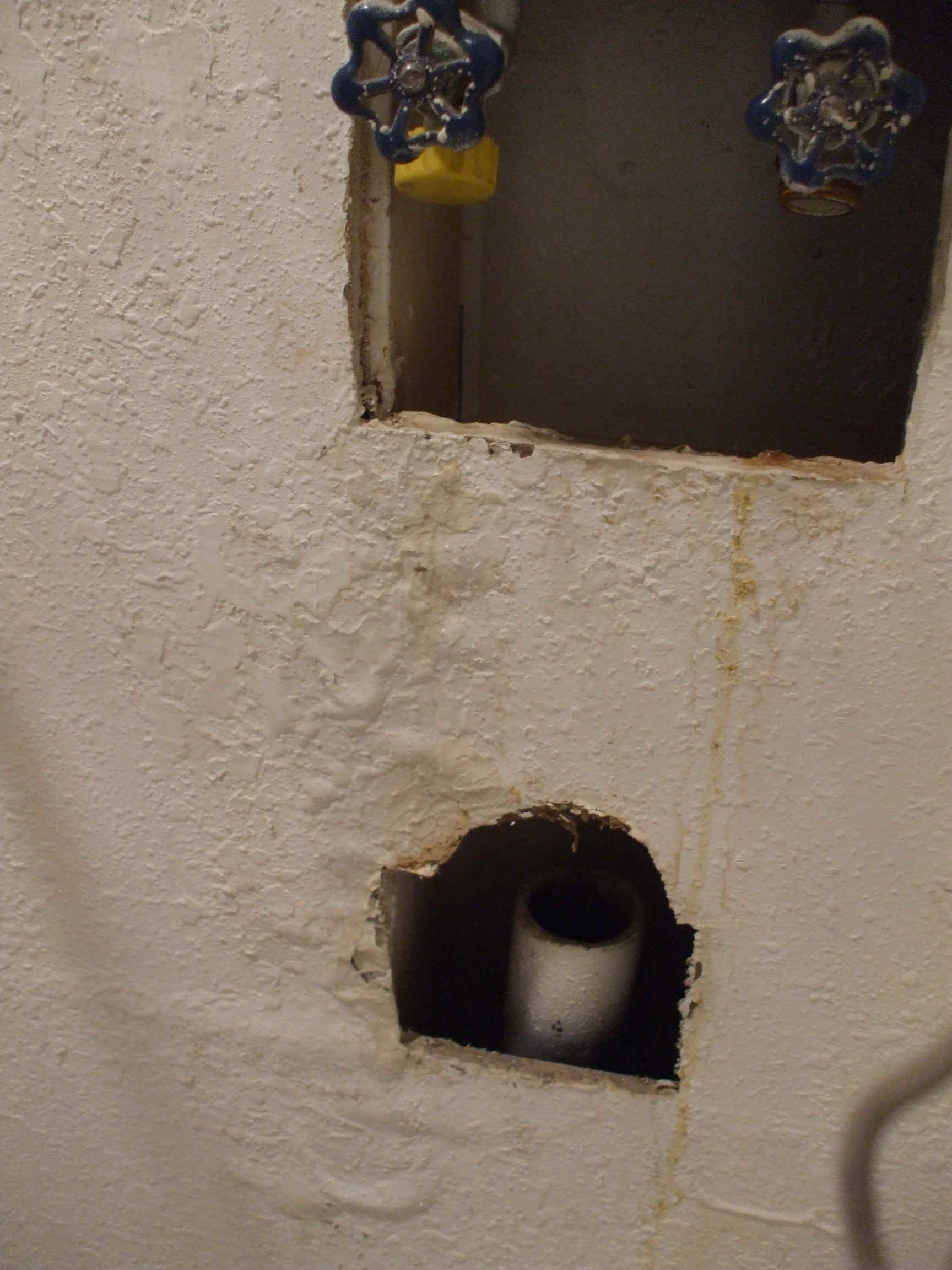 |
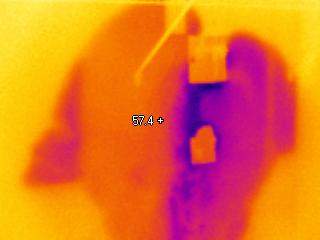 |
The dark images that show up with Infrared is moisture intrusion.
Note: The yellow device in the upper right picture is a moisture meter.
It is used to verify the presence of moisture.
Back to Top
Radon Explained

 Radon gas
destroys lives! As the second leading cause of lung cancer, radon kills thousands every
year. A substance to which no one
is immune! Radon exists worldwide. Without the
proper precautions, this radioactive gas can destroy your family. Now there is an easy and
affordable way to test for dangerous levels of radon gas. Radon gas
destroys lives! As the second leading cause of lung cancer, radon kills thousands every
year. A substance to which no one
is immune! Radon exists worldwide. Without the
proper precautions, this radioactive gas can destroy your family. Now there is an easy and
affordable way to test for dangerous levels of radon gas.
Isn't your family's health worth it?
|

|
|
|

Radon Atom |
Radon gas cannot be seen, smelled or tasted, but it exists
in the air you breathe. You are likely to gain the most exposure to Radon in your own
home, where you spend most of your time. Without proper precautions, Radon can build up to
toxic levels and put your family members in danger of developing lung cancer. Get a radon test kit now! |
|
|
|
|
|
| Attention Smokers: Radon has been found to be only second to
smoking as the major cause of lung cancer. If you smoke and are exposed to high levels of
Radon, your risk of developing lung cancer is higher than you think! Radon Myths & Facts
|
 |
The Basics on radon gas?
Radon (chemical symbol Rn) is a naturally occurring
radioactive gas found in soils, rock, and water throughout the U.S. It has numerous
different isotopes, but radon-220, and -222 are the most common. Radon causes lung cancer,
and is a threat to health because it tends to collect in homes, sometimes to very high
concentrations. As a result, radon is the largest source of exposure to naturally
occurring radiation.
Who discovered radon?
The German chemist Friedrich E. Dorn discovered radon-222
in 1900, and called it radium emanation. However, a scarcer isotope, radon-220, was
actually observed first, in 1899, by British scientists R.B. Owens and Ernest Rutherford.
The medical community nationwide became aware of radon in 1984. That year a nuclear plant
worker in Pennsylvania discovered radioactivity on his clothing while exiting his place of
work through the radiation detectors. The source of the radiation was determined to be
radon decay products on his clothing originating from his home.
Where does radon come from?
Radon-222 is the decay product of radium-226. Radon-222
and its parent, radium-226, are part of the long decay chain for uranium-238. Since
uranium is essentially ubiquitous in the earth's crust, radium-226 and radon-222 are
present in almost all rock, soil, and water.
"Home Buyer's and Seller's
Guide to Radon"
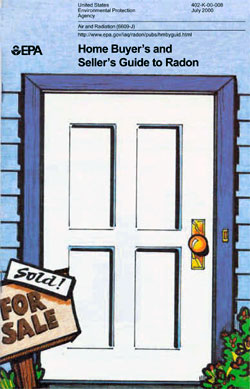 |
Office of Air and Radiation (OAR),
Office of Radiation and Indoor Air (ORIA) (6609J)
402-K-00-008, July 2000
EPA Recommends:
- If you are buying a home or selling your home, have it
tested for radon.
- For a new home, ask if radon-resistant construction
features were used and if the home has been tested.
- Fix the home if the radon level is 4 PicoCuries per liter
(pCi/L) or higher.
- Radon levels less than 4 pCi/L still pose a risk, and in
many cases, may be reduced.
- Take steps to prevent device interference when conducting
a radon test.
|
An Adobe Acrobat PDF version of this document is
also available [hmbuygud.pdf].
 |
| Based on information contained
in the National Academy of Sciences report, The Health Effects of Exposure to Indoor
Radon, radon is estimated to cause between 15,000 and 22,000 lung cancer deaths per
year. Data on (non-radon) causes of death are from Injury Facts, 1999 Edition,
National Safety Council, Itasca, IL. |
OVERVIEW
This Guide answers important questions about radon
and lung cancer risk. It also answers questions about testing and fixing for anyone
buying or selling a home.
Radon Is a Cancer-Causing, Radioactive Gas
You cannot see, smell, or taste radon. But it still may
be a problem in your home. When you breathe air containing radon, you increase your
risk of getting lung cancer. In fact, the Surgeon General of the United States has
warned that radon is the second leading cause of lung cancer in the United States
today. If you smoke and your home has high radon levels, your risk of lung cancer
is especially high.
National Academy of Sciences Report
on Radon
In February 1998, the National Academy of Sciences (NAS)
released its report on radon and lung cancer, The Health Effects of Exposure to Indoor
Radon (the BEIR VI report). The NAS is an independent, non-governmental,
scientific organization. The NAS estimates that radon causes between 15,000 and
22,000 lung cancer deaths each year in the United States and that 12 percent of all lung
cancer deaths are linked to radon. The BEIR VI Committee (Biological Effects of
Ionizing Radiation) concluded that after smoking, radon is the second leading cause of
death due to lung cancer in the United States. |
You Should Test for Radon
Testing is the only way to find out your home's radon
levels. EPA and the Surgeon General recommend testing all homes below the third floor for
radon.
You Can Fix a Radon Problem
If you find that you have high radon levels, there are
ways to fix a radon problem. Even very high levels can be reduced to acceptable levels.
If You Are Selling a Home...
EPA recommends that you test your home before putting it
on the market and, if necessary, lower your radon levels. Save the test results and all
information you have about steps that were taken to fix any problems. This could be a
positive selling point.
If You Are Buying a Home...
EPA recommends that you know what the indoor radon level
is in any home you consider buying. Ask the seller for their radon test
results. If the home has a radon-reduction system, ask the seller for information
they have about the system.
If the home has not yet been tested, you should have the
housed tested.
If you are having a new home built, there are features
that can be incorporated into your home during construction to reduce radon levels.
The radon testing guidelines in this Guide have
been developed specifically to deal with the time-sensitive nature of home purchases and
sales, and the potential for radon device interference. These guidelines are
slightly different from the guidelines in other EPA publications which provide radon
testing and reduction information for non-real estate situations.
This Guide recommends three short-term testing
options for real estate transactions. EPA also recommends testing a home in the
lowest level which is currently suitable for occupancy, since a buyer may choose to live
in a lower area of the home than that used by the seller.
Radon is a radioactive gas that has been found in homes
all over the United States. It comes from the natural breakdown of uranium in soil, rock
and water and gets into the air you breathe. Radon typically moves up through the ground
to the air above and into your home through cracks and other holes in the foundation.
Radon can also enter your home through well water. Your home can trap radon inside.
Any home can have a radon problem. This means new and old
homes, well-sealed and drafty homes, and homes with or without basements. In fact, you and
your family are most likely to get your greatest radiation exposure at home. That is where
you spend most of your time.
Nearly 1 out of every 15 homes in the United States is
estimated to have an elevated radon level (4 pCi/L or more). Elevated levels of
radon gas have been found in homes in your state. Contact your state radon office for
information about radon in your area.
Testing is the only way to know if you and your family
are at risk from radon. EPA and the Surgeon General recommend testing all homes below the
third floor for radon.
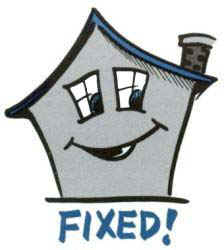 You cannot predict radon levels based on state, local,
and neighborhood radon measurements. Do not rely on radon test results taken in
other homes in the neighborhood to estimate the radon level in your home. Homes
which are next to each other can have different radon levels. Testing is the only
way to find out what your home's radon level is. You cannot predict radon levels based on state, local,
and neighborhood radon measurements. Do not rely on radon test results taken in
other homes in the neighborhood to estimate the radon level in your home. Homes
which are next to each other can have different radon levels. Testing is the only
way to find out what your home's radon level is.
In some areas, companies may offer different types of
radon service agreements. Some agreements let you pay a one-time fee that covers
both testing and radon mitigation, if needed. Contact your state radon office to
find out if these are available in your state.
| Surgeon General of the
United States Health Advisory "Indoor
radon gas is a national health problem. Radon causes thousands of deaths each
year. Millions of homes have elevated radon levels. Most homes should be tested for
radon. When elevated levels are confirmed, the problem should be corrected." |
If you are thinking of selling your home and you have
already tested your home for radon, review the Radon Testing Checklist to
make sure that the test was done correctly. If so, provide your test results to the
buyer.
No matter what kind of test you took, a potential buyer
may ask for a new test especially if:
- The Radon Testing Checklist items were not met;
- The last test is not recent, e.g., within two years;
- You have renovated or altered your home since you tested;
or
- The buyer plans to live in a lower level of the house than
was tested, such as a basement suitable for occupancy but not currently lived in.
A buyer may also ask for a new test if your state or
local government requires disclosure of radon information to buyers.
Have a test taken as soon as possible. If you can, test
your home before putting it on the market. You should test in the lowest level of
the home which is suitable for occupancy. This means testing in the lowest level that you
currently live in or a lower level not currently used, but which a buyer could use for
living space without renovations.
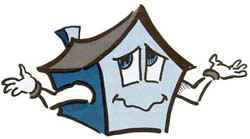 The radon test result is
important information about your home's radon level. Some states require radon
measurement testers to follow a specific testing protocol. If you do the test
yourself, you should carefully follow the testing protocol for your area or EPA's Radon
Testing Checklist. If you hire a contractor to test your residence, protect yourself
by hiring a qualified individual or company. The radon test result is
important information about your home's radon level. Some states require radon
measurement testers to follow a specific testing protocol. If you do the test
yourself, you should carefully follow the testing protocol for your area or EPA's Radon
Testing Checklist. If you hire a contractor to test your residence, protect yourself
by hiring a qualified individual or company.
You can determine a service provider's qualifications to
perform radon measurements or to mitigate your home in several ways. Check with your
state radon office. Many states require radon professionals to be licensed,
certified, or registered. Most states can provide you with a list of knowledgeable
radon service providers doing business in the state. In states that don't regulate
radon services, ask the contractor if they hold a professional proficiency or
certification credential. Such programs usually provide members with a photo-ID
card, which indicates their qualifications and its expiration date. If in doubt, you
should check with their credentialing organization. Alternatively, ask the
contractor if they've successfully completed formal training appropriate for testing or
mitigation, e.g., a course in radon measurement or radon mitigation.
If you are thinking of buying a home, you may decide to
accept an earlier test result from the seller, or ask the seller for a new test to
be conducted by a qualified radon tester. Before you accept the seller's test, you
should determine:
- The results of previous testing;
- Who conducted the previous test: the homeowner, a
radon professional, or some other person;
- Where in the home the previous test was taken, especially
if you may plan to live in a lower level of the home. For example, the test may have
been taken on the first floor. However, if you want to use the basement as living
space, test there; and
- What, if any, structural changes, alterations, or changes
in the heating, ventilation, and air conditioning (HVAC) system have been made to the
house since the test was done. Such changes may affect radon levels.
If you accept the seller's test, make sure that the test
followed the Radon Testing Checklist.
If you decide that a new test is needed, discuss it with
the seller as soon as possible.
Make sure that a radon test is done as soon as possible.
Consider including provisions in the contract specifying:
- Where the test will be located;
- Who should conduct the test;
- What type of test to do;
- When to do the test;
- How the seller and the buyer will share the test results
and test costs (if necessary); and
- When radon mitigation measures will be taken and who will
pay for them.
Make sure that the test is done in the lowest level of
the home suitable for occupancy. This means the lowest level that you are going to use as
living space which is finished or does not require renovations prior to use. A state
or local radon official or qualified radon tester can help you make some of these
decisions.
If you decide to finish or renovate an unfinished area of
the home in the future, a radon test should be taken before starting the project and after
the project is finished. Generally, it is less expensive to install a radon-reduction
system before (or during) renovations rather than afterwards.
Radon-resistant techniques work. When installed
properly and completely, these simple and inexpensive passive techniques can help to
reduce radon levels. In addition, installing them at the time of construction makes
it easier to reduce radon levels further if the passive techniques don't reduce radon
levels below 4 pCi/L. Radon-resistant techniques may also help to lower moisture
levels and those of other soil-gases. Radon-resistant techniques:
 |
Making Upgrading Easy: Even if built
to be radon-resistant, every new home should be tested for radon after occupancy. If
you have a test result of 4 pCi/L or more, a vent fan can easily be added to the passive
system to make it an active system and further reduce radon levels. |
 |
Are Cost-Effective: Building
radon-resistant features into the house during construction is easier and cheaper than
fixing a radon problem from scratch later. Let your builder know that
radon-resistant features are easy to install using common building materials. |
 |
Save Money: When installed properly
and completely, radon-resistant techniques can also make your home more energy efficient
and help you save on your energy costs. |
In a new home, the cost to install passive
radon-resistant features during construction is usually between $350 and $500. In
some areas, the cost may be as low as $100. A qualified mitigator will charge about
$300 to add a vent fan to a passive system, making it an active system and further
reducing radon levels. In an existing home, it usually costs between $800 and
$2,500 to install a radon mitigation system.
Radon-resistant techniques (features) may vary for
different foundations and site requirements. If you're having a house built, you can
learn about EPA's Model Standards (and architectural drawings) and explain the techniques
to your builder. If your new house was built (or will be built) to be
radon-resistant, it will include these basic elements:
- Gas-Permeable Layer: This layer is placed
beneath the slab or flooring system to allow the soil gas to move freely underneath the
house. In many cases, the material used is a 4-inch layer of clean gravel.
This gas-permeable layer is used only in homes with basement and slab-on-grade
foundations; it is not used in homes with crawlspace foundations.
- Plastic Sheeting: Plastic sheeting is placed
on top of the gas-permeable layer and under the slab to help prevent the soil gas from
entering the home. In crawl spaces, the sheeting (with seams sealed) is placed
directly over the crawlspace floor.
- Sealing and Caulking: All below-grade
openings in the foundation and walls are sealed to reduce soil gas entry into the home.
- Vent Pipe: A 3- or 4-inch PVC pipe (or other
gas-tight pipe) runs from the gas-permeable layer through the house to the roof, to safely
vent radon and other soil gases to the outside.
- Junction Boxes: An electrical junction box is
included in the attic to make the wiring and installation of a vent fan easier. For
example, you decide to activate the passive system because your test result showed an
elevated radon level (4 pCi/L or more). A separate junction box is placed in the
living space to power the vent fan alarm. An alarm is installed along with the vent
fan to indicate when the vent fan is not operating properly.
|
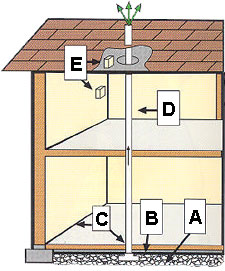 |
Radon testing is easy and the only way to find out if you
have a radon problem in your home.
Since you cannot see or smell radon, special equipment is
needed to detect it. When you're ready to test your home, you can order a radon test
kit by mail from a qualified radon measurement services provider or laboratory. You
can also hire a qualified radon tester, very often a home inspector, who will use a radon
device(s) suitable to your situation. The most common types of radon testing devices
are listed below.
Passive Devices
Passive radon testing devices do not need power to
function. These include charcoal canisters, alpha-track detectors, charcoal
liquid scintillation devices, and electret ion chamber detectors which are
available at http://www.testproducts.com/safecart.
These devices are exposed to the air in the home for a specified period of time and then
sent to our laboratory for analysis. Both short-term and long-term passive devices
are generally inexpensive. Some of these devices may have features that offer more
resistance to test interference or disturbance than other passive devices. Qualified radon
testers may use any of these devices to measure the home's radon level.
Active Devices
Active radon testing devices require power to function.
These include continuous radon monitors and continuous working level monitors.
They continuously measure and record the amount of radon or its decay products in the
air. Many of these devices provide a report of this information which can reveal any
unusual or abnormal swings in the radon level during the test period. A qualified tester
can explain this report to you. In addition, some of these devices are specifically
designed to deter and detect test interference. Some technically advanced active devices
offer anti-interference features. Although these tests may cost more, they may
ensure a more reliable result.
A state or local radon official can explain the
differences between devices and recommend the ones which are most appropriate for your
needs and expected testing conditions.
Make sure to use a radon measurement device from a
qualified laboratory. Certain precautions should be followed to avoid interference
during the test period. See the Radon Testing Checklist for more information
on how to get a reliable test result.
Radon Test Device Placement
EPA recommends that testing device(s) be placed in the
lowest level of the home suitable for occupancy. This means testing in the lowest
level (such as a basement), which a buyer could use for living space without renovations.
The test should be conducted in a room to be used regularly (like a family room, living
room, playroom, den or bedroom); do not test in a kitchen, bathroom, laundry room
or hallway. Usually, the buyer decides where to locate the radon test, based on
their expected use of the home. A buyer and seller should explicitly discuss and
agree on the test location to avoid any misunderstanding. Their decision should be
clearly communicated to the person performing the test. |
There is a potential for test interference in real estate
transactions. There are several ways to prevent or detect test interference:
- Use a test device that frequently records radon or decay
product levels to detect unusual swings;
- Employ a motion detector to determine whether the test
device has been moved or testing conditions have changed;
- Use a proximity detector to reveal the presence of people
in the room which may correlate to possible changes in radon levels during the test;
- Record the barometric pressure to identify weather
conditions which may have affected the test;
- Record the temperature record to help assess whether doors
and windows have been opened;
- Apply tamper-proof seals to windows to ensure closed house
conditions; and
- Have the seller/occupant sign a non-interference
agreement.
Home buyers and sellers should consult a qualified radon
test provider about the use of these precautions.
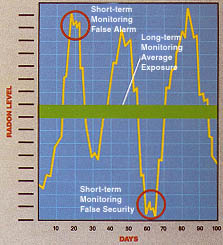
|
What’s the difference between
short-term and long-term testing?
Radon gas levels in a home are not the same every day. Changes in
the weather, how often windows and doors are opened and closed, the type of air
conditioning/heating systems you use, and your family's lifestyle all contribute to the
level of radon gas in your home each day. A short-term test may show unusually high or low
levels due to the weather and activity in your home. A long-term test will average your
exposure to radon levels over a period of time, and experts agree that this gives a more
conclusive test result.
There Are Two General Ways To Test Your Home for
Radon:
Because radon levels vary from day to day and season to
season, a short-term test is less likely than a long-term test to tell you your year-round
average radon level. However, if you need results quickly, a short-term test may be
used to decide whether to fix the home.
 |
Short-Term Testing |
The quickest way to test is with short-term tests.
Short-term tests remain in your home from two days to 90 days, depending on the device.
There are two groups of devices which are more commonly used for short-term testing. The
passive device group includes alpha track detectors, charcoal canisters, charcoal
liquid scintillation detectors, and electret ion chambers. The active device
group consists of different types of continuous monitors.
| Whether you test for
radon yourself or hire a state-certified tester or a privately certified tester, all radon
tests should be taken for a minimum of 48 hours. A longer period of testing is required
for some devices. |
Visit our radon test kit &
detector Product Catalog
 |
Long-Term Testing |
Long-term tests remain in your home for more than 90
days. Alpha track, and electret ion chamber detectors are commonly used for
this type of testing. A long-term test will give you a reading that is more likely to tell
you your home's year-round average radon level than a short-term test. If time permits
(more than 90 days) long-term tests can be used to confirm initial short-term results.
When long-term test results are 4 pCi/L or higher, EPA recommends fixing the home.
If you are testing in a real estate transaction and you
need results quickly, any of the following three options for short-term Tests are
acceptable in determining whether the home should be fixed. Any real estate test for radon
should include steps to prevent or detect device interference with the test device.
When Choosing a Short-Term Testing
Option...
There are trade-offs among the short-term testing
options. Two tests taken at the same time (simultaneous) would improve the precision
of this radon test. One test followed by another test (sequential) would most likely
give a better representation of the seasonal average. Both active and passive
devices may have features which help to prevent test interference. Your state radon
office can help you decide which option is best. |
| Short-Term
Testing Options |
What
to do Next |
Passive:
Take two short-term tests at the same time in the same location for at least 48
hours. or
Take an initial short-term test for at least 48
hours. Immediately upon completing the first test, do a second test using an
identical device in the same location as the first test. |
Fix the home if the average of two tests is 4 pCi/L or more.
Fix the home if the average of the two tests is 4 pCi/L
or more. |
Active:
Test the home with a continuous monitor for at least 48 hours. |
Fix the home if the average radon level is 4 pCi/L or more. |
If You Do the Test Yourself
 When you are taking a
short-term test, close windows and doors and keep them closed, except for normal entry and
exit. If you are taking a short-term test lasting less than four days, be sure to: When you are taking a
short-term test, close windows and doors and keep them closed, except for normal entry and
exit. If you are taking a short-term test lasting less than four days, be sure to:
- Close your windows and outside doors at least 12 hours
before beginning the test;
- Do not conduct short-term tests lasting less than four
days during severe storms or periods of high winds;
- Follow the testing instructions and record the start time
and date;
- Place the test device at least 20 inches above the floor
in a location where it will not be disturbed and where it will be away from drafts, high
heat, high humidity, and exterior walls;
- Leave the test kit in place for as long as the test
instructions say; and
- Once you have finished the test, record the stop time and
date, reseal the package and return it immediately to the lab specified on the package for
analysis.
You should receive your test results within a few weeks.
If you need results quickly, you should find out how long results will take and, if
necessary, request expedited service.
 |
If You Hire a Qualified Radon Tester |
In many cases, home buyers and sellers may decide to have
the radon test done by a qualified radon tester who knows the proper conditions, test
devices, and guidelines for obtaining a reliable radon test result. They can also:
- Evaluate the home and recommend a testing approach
designed to make sure you get reliable results;
- Explain how proper conditions can be maintained during the
radon test;
- Emphasize to occupants of a home that a reliable test
result depends on their cooperation. Interference with, or disturbance of, the test
or closed-house conditions will invalidate the test result;
- Analyze the data and report measurement results; and
- Provide an independent test.
The average indoor radon level is estimated to be about
1.3 pCi/L; roughly 0.4 pCi/L of radon is normally found in the outside air. The U.S.
Congress has set a long-term goal that indoor radon levels be no more than outdoor levels.
While this goal is not yet technologically achievable for all homes, radon levels in many
homes can be reduced to 2 pCi/L or below.
Radon Test Results Reported in Two
Ways
Your radon test results may be reported in either
picoCuries per liter of air (pCi/L) or working levels (WL). If your test result is in
pCi/L, EPA recommends you fix your home if your radon level is 4 pCi/L or higher. If the
test result is in WL, EPA recommends you fix the home if the working level is 0.02 WL or
higher. Some states require WL results to be converted to pCi/L to minimize
confusion. |
Sometimes short-term tests are less definitive about
whether the home is at or above 4 pCi/L; particularly when the results are close to 4
pCi/L. For example, if the average of two short-term tests is 4.1 pCi/L, there is about a
50% chance that the year-round average is somewhat below 4 pCi/L.
However, EPA believes that any radon exposure carries
some risk; no level of radon is safe. Even radon levels below 4 pCi/L pose some
risk. You can reduce your risk of lung cancer by lowering your radon level.
As with other environmental pollutants, there is
some uncertainty about the magnitude of radon health risks. However, we know more about
radon risks than risks from most other cancer-causing substances. This is because
estimates of radon risks are based on data from human studies (underground miners).
Additional studies on more typical populations are under way.
Your radon measurement will give you an idea of your risk
of getting lung cancer from radon. Your chances of getting lung cancer from radon depend
mostly on:
- Your home's radon level;
- The amount of time you spend in your home; and
- Whether you are a smoker or have ever smoked.
Smoking combined with radon is an especially serious
health risk. If you smoke or are a former smoker, the presence of radon greatly increases
your risk of lung cancer. If you stop smoking now and lower the radon level in your house,
you will reduce your lung cancer risk.
Based on information contained in the National Academy of
Sciences 1998 report, The Health Effects of Exposure to Indoor Radon, your radon
risk may be somewhat higher than shown; especially if you have never smoked.
It's never too late to reduce your risk to lung cancer. Don't wait to test and fix a
radon problem. If you are a smoker, stop smoking.
Radon Risk Comparison Charts
It's never too late to reduce your risk of lung
cancer.
Don't wait to test and fix a radon problem.
If you are a smoker, stop smoking.
| RADON RISK IF YOU SMOKE |
| Radon
Level |
If
1,000 people who smoked were exposed to this level over a lifetime... |
The
risk of cancer from radon exposure compares to... |
WHAT
TO DO:
Stop smoking and... |
| 20 pCi/L |
About 135 people could get lung cancer |
100 times the risk of drowning |
Fix your home |
| 10 pCi/L |
About 71 people could get lung cancer |
100 times the risk of dying in a home fire |
Fix your home |
| 8 pCi/L |
About 57 people could get lung cancer |
|
Fix your home |
| 4 pCi/L |
About 29 people could get lung cancer |
100 times the risk of dying in an airplane crash |
Fix your home |
| 2 pCi/L |
About 15 people could get lung cancer |
2 times the risk of dying in a car crash |
Consider fixing between 2 and 4 pCi/L |
| 1.3 pCi/L |
About 9 people could get lung cancer |
(Average indoor radon level) |
(Reducing radon levels below 2 pCi/L is difficult.) |
| 0.4 pCi/L |
About 3 people could get lung cancer |
(Average outdoor radon level) |
(Reducing radon levels below 2 pCi/L is difficult.) |
| Note: If you are a former smoker,
your risk may be lower. |
| RADON RISK IF YOU HAVE NEVER SMOKED |
| Radon
Level |
If
1,000 people who never smoked were exposed to this level over a lifetime... |
The
risk of cancer from radon exposure compares to... |
WHAT
TO DO: |
| 20 pCi/L |
About 8 people could get lung cancer |
The risk of being killed in a violent crime |
Fix your home |
| 10 pCi/L |
About 4 people could get lung cancer |
|
Fix your home |
| 8 pCi/L |
About 3 people could get lung cancer |
10 times the risk of dying in an airplane crash |
Fix your home |
| 4 pCi/L |
About 2 people could get lung cancer |
The risk of drowning |
Fix your home |
| 2 pCi/L |
About 1 person could get lung cancer |
The risk of dying in a home fire |
Consider fixing between 2 and 4 pCi/L |
| 1.3 pCi/L |
Less than 1 person could get lung cancer |
(Average indoor radon level) |
(Reducing radon levels below 2 pCi/L is difficult.) |
| 0.4 pCi/L |
Less than 1 person could get lung cancer |
(Average outdoor radon level) |
(Reducing radon levels below 2 pCi/L is difficult.) |
| Note: If you are a former smoker, your
risk may be higher. |
|
For reliable test results, follow this Radon Testing
Checklist carefully. Testing for radon is not complicated. Improper
testing may yield inaccurate results and require another test. Disturbing or
interfering with the test device, or with closed-house conditions, may invalidate the test
results and is illegal in some states. If the seller or qualified tester cannot
confirm that all items have been completed, take another test.
 |
Before Conducting a Radon Test: |
- Notify the occupants of the importance of proper testing
conditions. Give the occupants written instructions or a copy of this Guide and explain
the directions carefully.
- Conduct the radon test for a minimum of 48 hours; some
test devices have a minimum exposure time greater than 48 hours.
- When doing a short-term test ranging from 2-4 days, it is
important to maintain closed-house conditions for at least 12 hours before the beginning
of the test and during the entire test period.
- When doing a short-term test ranging from 4-7 days, EPA
recommends that closed-house conditions be maintained.
- If you conduct the test yourself, use a qualified radon
measurement device and follow the laboratory's instructions. Your state may be able
to provide you with a list of do-it-yourself test devices available from qualified
laboratories.
- If you hire someone to do the test, hire only a qualified
individual. Some states issue photo identification (ID) cards; ask to see it.
The tester's ID number, if available, should be included or noted in the test report.
- The test should include method(s) to prevent or detect
interference with testing conditions or with the testing device itself.
- If the house has an active radon-reduction system, make
sure the vent fan is operating properly. If the fan is not operating properly, have
it (or ask to have it) repaired and then test.
| Closed-house conditions means keeping all windows
closed, keeping doors closed except for normal entry and exit, and not operating fans or
other machines which bring in air from outside. Fans that are part of a
radon-reduction system or small exhaust fans operating for only short periods of time may
run during the test. |
 |
During a Radon Test: |
- Maintain closed-house conditions during he entire time of
a short term test, especially for tests shorter than one week in length.
- Operate the home's heating and cooling systems normally
during the test. For tests lasting less than one week, operate only air-conditioning units
which recirculate interior air.
- Do not disturb the test device at any time during the
test.
- If a radon-reduction system is in place, make sure the
system is working properly and will be in operation during the entire radon test.
 |
After a Radon Test: |
- If you conduct the test yourself, be sure to promptly
return the test device to the laboratory. Be sure to complete the required
information, including start and stop times, test location, etc.
- If an elevated level is found, fix the home. Contact a
qualified radon-reduction contractor about lowering the radon level. EPA recommends
that you fix the home when the radon level is 4 pCi/L or more.
- Be sure that you or the radon tester can demonstrate or
provide information to ensure that the testing conditions were not violated during the
testing period.
EPA recommends that you take action to reduce your home's
indoor radon levels if your radon test result is 4 pCi/L or higher. It is better to
correct a radon problem before placing your home on the market because then you have more
time to address a radon problem.
If elevated levels are found during the real estate
transaction, the buyer and seller should discuss the timing and costs of the radon
reduction. The cost of making repairs to reduce radon levels depends on how your
home was built and other factors. Most homes can be fixed for about the same cost as other
common home repairs, like painting or having a new hot water heater installed. The average
cost for a contractor to lower radon levels in a home can range from $800 to about $2,500.
A variety of methods can be used to reduce radon in
homes. Sealing cracks and other openings in the foundation is a basic part of most
approaches to radon reduction. EPA does not recommend the use of sealing alone
to limit radon entry. Sealing alone has not been shown to lower radon levels
significantly or consistently.
In most cases, a system with a vent pipe(s) and
fan(s) is used to reduce radon. These "sub-slab depressurization" systems
do not require major changes to your home. Similar systems can also be installed in homes
with crawl space. These systems prevent radon gas from entering the home from below
the concrete floor and from outside the foundation. Radon mitigation contractors may
use other methods that may also work in your home. The right system depends on the design
of your home and other factors.
Techniques for reducing radon are discussed in EPA's
"Consumer's
Guide to Radon Reduction." As with any other household appliance, there are
costs associated with the operation of the radon-reduction system.
Radon and
home renovations
If you are planning any major renovations, such as
converting an unfinished basement area into living space, it is especially important to
test the area for radon before you begin.
If your test results indicate an elevated radon level,
radon-resistant techniques can be inexpensively included as part of the renovation. Major
renovations can change the level of radon in any home. Test again after the work is
completed. |
You should also test your home again after it is fixed to
be sure that radon levels have been reduced. If your living patterns change and you begin
occupying a lower level of your home (such as a basement) you should retest your home on
that level. In addition, it is a good idea to retest your home sometime in the future to
be sure radon levels remain low.
Select a qualified radon-reduction contractor to reduce
the radon levels in your home. Any mitigation measures taken or system installed in
your home must conform to your state's regulations. In states without regulations
covering mitigation, the system should conform to EPA's Radon Mitigation Standards.
EPA recommends that the mitigation contractor review the
radon measurement results before beginning and radon-reduction work. Test again
after the radon mitigation work has been completed to confirm that previous elevated
levels have been reduced.
A qualified radon-reduction (mitigation) contractor
should be able to:
- Review testing guidelines and measurement results, and
determine if additional measurements are needed;
- Evaluate the radon problem and provide you with a
detailed, written proposal on how radon levels will be lowered;
- Design a radon-reduction system;
- Install the system according to EPA standards, or state or
local codes; and
- Make sure the finished system effectively reduces radon
levels to acceptable levels.
Choose a radon mitigation contractor to fix your radon
problem just as you would for any other home repair. You may want to get more than
one estimate, ask for and check their references. Make sure the person you hire is
qualified to install a mitigation system. Some states regulate or certify radon
mitigation services providers.
Be aware that a potential conflict of interest exists if
the same person or firm performs the testing and installs the mitigation system.
Some states may require the homeowner to sign a waiver in such cases. If the same
person or firm does the testing and mitigation, make sure the testing is done in
accordance with the Radon Testing Checklist. Contact your
state radon office for more information.
The radon in your home's indoor air can come from two
sources, the soil or your water supply. Compared to radon entering your home through
water, radon entering your home through soil is a much larger risk. If you've tested
for radon in air and have elevated radon levels and your water comes from a private well,
have your water tested. The devices and procedures for testing your home's water
supply are different from those used for measuring radon in air.
The radon in your water supply poses an inhalation risk
and an ingestion risk. Research has shown that your risk of lung cancer from
breathing radon in air is much larger than your risk of stomach cancer from swallowing
water with radon in it. Most of your risk from radon in water comes from radon
released into the air when water is used for showering and other household purposes.
Radon in your home's water in not usually a problem when
its source is surface water. A radon in water problem is more likely when its source
is ground water, e.g., a private well or a public water supply system that uses ground
water. Some public water systems treat their water to reduce radon levels before it
is delivered to your home. If you are concerned that radon may be entering your home
through the water and your water comes from a public water supply, contact your water
supplier.
 If you've tested your private well and have a
radon in water problem, it can be fixed. Your home's water supply can be treated in one of
two ways. Point-of-entry treatment can effectively remove radon from the water
before it enters your home. Point-of-entry treatment usually employs either granular
activated carbon (GAC) filters or aeration devices. While GAC filters usually cost
less than aeration devices, filters can collect radioactivity and may require a special
method of disposal. Point-of-use treatment devices remove radon from your water at
the tap, but only treat a small portion of the water you use, e.g., the water you
drink. Point-of-use devices are not effective in reducing the risk from breathing
radon released into the air from all water used in the home. If you've tested your private well and have a
radon in water problem, it can be fixed. Your home's water supply can be treated in one of
two ways. Point-of-entry treatment can effectively remove radon from the water
before it enters your home. Point-of-entry treatment usually employs either granular
activated carbon (GAC) filters or aeration devices. While GAC filters usually cost
less than aeration devices, filters can collect radioactivity and may require a special
method of disposal. Point-of-use treatment devices remove radon from your water at
the tap, but only treat a small portion of the water you use, e.g., the water you
drink. Point-of-use devices are not effective in reducing the risk from breathing
radon released into the air from all water used in the home.
|
Isn't it worth your family's health?
Radon testing is an important part of assuring your family's risk
of Radon Gas causing ailments to be reduced. Radon kills. Order your radon test kit today!
EPA Map of Radon Zones
| The Map was developed using five factors to
determine radon potential: indoor radon measurements; geology; aerial radioactivity; soil
permeability; and, foundation type. Radon potential assessment is based on geologic
provinces. Radon Index Matrix is the quantitative assessment of radon potential.
Confidence Index Matrix shows the quantity and quality of the data used to assess radon
potential. Geologic Provinces were adapted to county boundaries for the Map of Radon
Zones. Sections 307 and 309 of the Indoor Radon
Abatement Act of 1988 (IRAA) directed EPA to list and identify areas of the U.S. with the
potential for elevated indoor radon levels. EPA's Map of Radon Zones assigns each of the
3,141 counties in the U.S. to one of three zones based on radon potential:
- Zone 1 counties have a predicted average indoor radon
screening level greater than 4 pCi/L (pico curies per liter) (red zones)
- Zone 2 counties have a predicted average indoor radon
screening level between 2 and 4 pCi/L (orange zones)
- Zone 3 counties have a predicted average indoor radon
screening level less than 2 pCi/L (yellow zones)
An Adobe Acrobat pdf version of the map is available
(suitable for printing): color - zonemapcolor.pdf (330KB
file) | black & white - b&wmap.pdf (101KB file)
You can view your State's radon potential map by clicking
on your State below. |
|
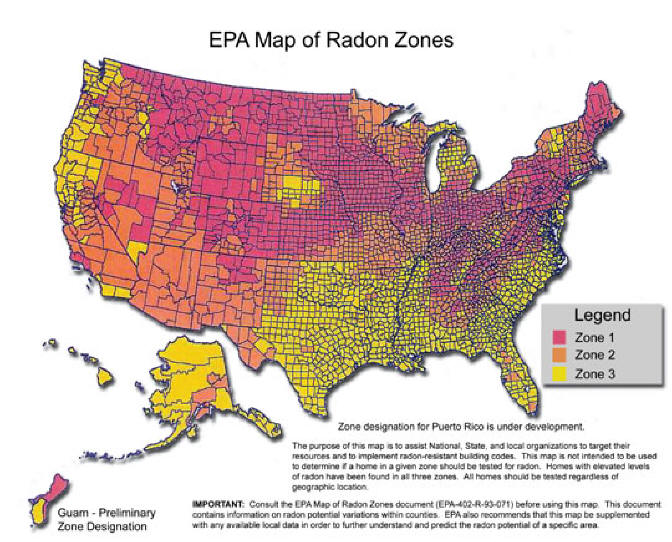
Alabama
|| Alaska || Arizona || Arkansas || California || Colorado || Connecticut || Delaware || Florida || Georgia || Hawaii || Idaho || Illinois || Indiana || Iowa || Kansas || Kentucky || Louisiana || Maine || Maryland || Massachusetts || Michigan || Minnesota || Mississippi || Missouri || Montana || Nebraska || Nevada || New Hampshire || New Jersey || New Mexico || New York || North Carolina || North Dakota || Ohio || Oklahoma || Oregon || Pennsylvania || Rhode Island || South Carolina || South Dakota || Tennessee || Texas || Utah || Vermont || Virginia || Washington || West Virginia || Wisconsin || Wyoming
The
contents of these WebPages are copyright protected
� 1996-2005, All rights reserved
NATIONAL SAFETY PRODUCTS, Inc.
Back to Top
Mold Testing/Survey
Unless you or your family have health problems that
concern you about the presents of mold, testing for mold usually is not
necessary. The fact is, every house has mold, just how much is the
question.
Some signs to look for in your home or the house you are
about to buy is:
- Is there a musty or unpleasant odor?
- Is there dampness?
- Is there water stains on the ceiling, walls or floor?
If any of these conditions are present you might want a
mold survey performed before you buy the house. Mold is not always
visible. It can hide very well. Wherever there is or has been a leak in
the house is a potential concern. Mold can lay dormant from an old leak,
just waiting for the right conditions to start growing again. Mold is
often found under carpet, inside the walls and ceilings. These area's can
not be inspected visually and are beyond the scope of a home inspection.
Other areas mold is found is inside the base cupboards and under the floor
system.
Every inspection we perform includes looking for mold
and conditions that are favorable for mold growth. In the event mold or
conditions are discovered I will talk to you about your options at that
time.
Now I'm different than most inspectors, I'm not out to
take your money needlessly. Even if mold is discovered, I explain the
scope and the hazards, if any. Mold testing can get expensive because the
samples need to be processed by an accredited laboratory and they charge a
fee.
If you require a mold survey, it could run $350.00 or
more depending on the size of the house. This is a small price to pay if
there is a serious mold issue. To remove the mold can cost 1000,s of
dollars.
If you have more questions or need a mold survey call
HomeFront Inspection to schedule a mold survey. 303-777-8025
Back to Top
Winterized Plumbing Air Test
Because of all the foreclosures and vacant homes
there are a lot of homes that are winterized. Usually, winterization
includes only turning off the water and draining the plumbing in the house
to prevent the pipes from freezing. However, sometimes the gas and the
electric is also turned off. All utilities must be on to do a thorough
inspection.
Most bank owned properties are winterized and the banks
require up to $350.00 just to turn on the water and then re-winterize the
house again after the inspection.
We have developed a process to pressurize the plumbing
system with air. We install a pressure gauge to monitor the integrity of
the plumbing system. If the pressure gauge drops during the testing
process we know there is a leak. We do our best to locate the leak and
most can be found, but not always. There are some limitations to this
process because not all water related components can be tested. Some of
these are:
These can not be tested with an air pressure test.
- Dishwasher
- Washing machine
- Humidifiers
- Drains
- Ice makers
- Toilet tank internal parts
- Sprinkler system
All the above items have easy access and can usually be
easily repaired. However, it there is a water leak in the water pipes the
water will eventually cause major damage to the house and create
conditions favorable for mold. Our main objective is to prevent
major problems to your home.
COST
There is an additional fee for the air pressure test. It
usually runs between $75 to $175.00 if conducted during a regular home
inspection. A plumbing air pressure test by it's self will cost $175 to
$300.
If you need an air pressure test be sure to call
HomeFront Inspection prior to the inspection because this requires special
equipment.
303-777-8025
Back to Top
Asbestos Testing
Many homes have asbestos material present either on the
outside or inside. Asbestos was commonly used in homes that were built
well into the 1980"s. If there are suspicious areas that may contain
asbestos the inspector will mention these to you at the inspection. Then
you can decide if you want to have it tested for asbestos. An accredited laboratory
needs to do the testing of the sample provided by the inspector.
Lead Base Paint Testing
Lead Base Paint (LBP) was banned in 1978. Homes that
were built prior to 1978 have the potential of having LBP. Lead in paint
is know to cause brain damage in small children. Small children are always
putting their fingers in their mouths. Dust from LBP, caused from opening
and closing doors and windows, can easily get on the child's hands and then
into their mouth. The Environmental Protection Agency (EPA) have strict
guidelines when it comes to removing LBP. If your house has LBP you should
visit www.epa.org and see what is
required when removing Lead Base Paint.
Back to Top |


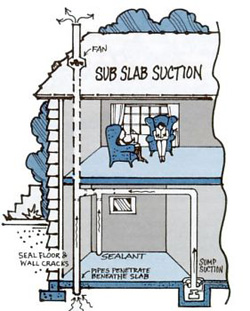 b. How To
Lower The Radon Level In Your Home
b. How To
Lower The Radon Level In Your Home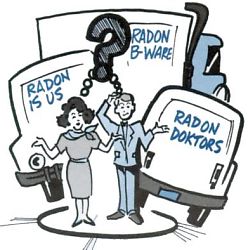 c.
Selecting a Radon-Reduction (Mitigation) Contractor
c.
Selecting a Radon-Reduction (Mitigation) ContractorIf you've tested your private well and have a radon in water problem, it can be fixed. Your home's water supply can be treated in one of two ways. Point-of-entry treatment can effectively remove radon from the water before it enters your home. Point-of-entry treatment usually employs either granular activated carbon (GAC) filters or aeration devices. While GAC filters usually cost less than aeration devices, filters can collect radioactivity and may require a special method of disposal. Point-of-use treatment devices remove radon from your water at the tap, but only treat a small portion of the water you use, e.g., the water you drink. Point-of-use devices are not effective in reducing the risk from breathing radon released into the air from all water used in the home.

